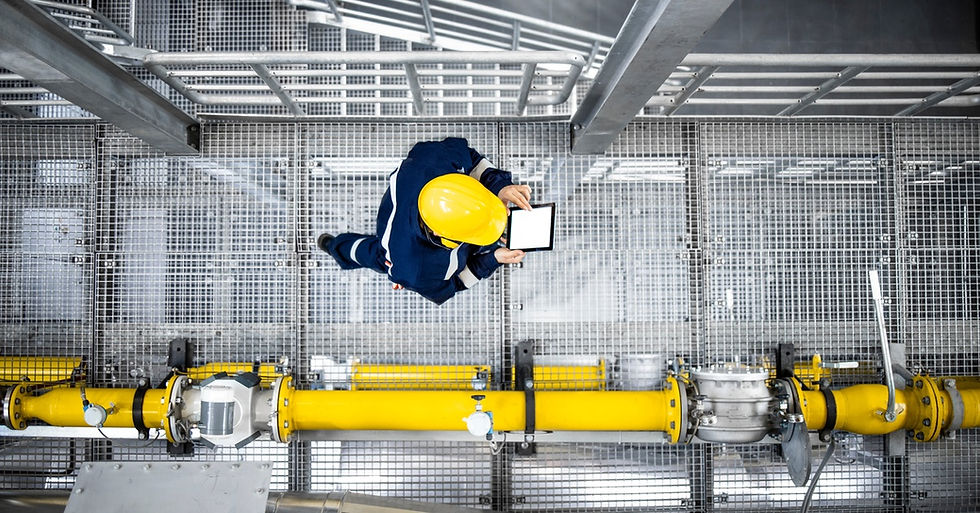5 Signs Your Facility Is Overdue for an Energy Audit
- Heidi Dorn
- 7 days ago
- 5 min read

Many facility managers know the frustration of watching energy costs climb month after month, yet they don’t realize they’re sitting on a goldmine of potential savings. An energy audit is a comprehensive assessment that examines how your facility uses energy, identifies inefficiencies, and provides actionable recommendations for improvement. Think of it as a health checkup for your building’s energy systems.
Energy audits have become essential tools for modern facility management, offering insights that can reduce operating costs while improving occupant comfort and environmental performance. Yet despite these compelling benefits, many facilities operate for years without proper energy assessments, missing opportunities to optimize their systems and reduce waste.
The question isn’t whether your facility could benefit from an energy audit—it’s whether you can afford to continue without one. Keep reading to learn about the signs your facility is overdue for an energy audit.
Your Energy Bills Keep Climbing
One of the most obvious indicators that your facility needs an energy audit is a pattern of rising energy costs that you can’t explain by rate increases or expanded operations. When your monthly utility bills consistently trend upward despite similar usage patterns, your building systems are likely operating inefficiently.
Energy costs should remain relatively stable for facilities with consistent occupancy and operations. Sudden spikes or gradual increases over several months often signal equipment degradation, system malfunctions, or operational inefficiencies that an audit can identify and address.
Sometimes these increases are subtle, making them easy to overlook amid other operational concerns. However, even modest increases compound significantly over time. A facility spending $50,000 annually on energy that experiences a 15 percent increase is actually losing $7,500 per year—money that the facility could use for improvements or other operational priorities.
Comparing your energy costs to similar facilities can also reveal problems. If your building consistently uses more energy per square foot than comparable structures in your area, underlying inefficiencies are likely driving up your costs.
Outdated Equipment Dominates Your Systems
Aging equipment is another sign your facility is overdue for an energy audit. HVAC systems over 15 years old, lighting fixtures using outdated technology, and machinery that predates modern efficiency standards all contribute to excessive energy consumption.
HVAC Systems
Older HVAC systems often operate at significantly reduced efficiency compared to their original specifications. Components wear down, refrigerant levels drop, and control systems become less precise. These gradual changes mean your heating and cooling equipment works harder to maintain desired conditions while consuming substantially more energy.
Lighting
Lighting is another area where outdated technology creates unnecessary expenses. Facilities that use incandescent bulbs, older fluorescent fixtures, or metal halide systems for warehouses and large spaces typically spend two to three times more on lighting. Modern LED systems use less energy and produce less heat, reducing cooling loads during warmer months.
Equipment
Manufacturing facilities and office buildings with aging equipment often discover that motor-driven systems, computers, and specialized machinery consume far more power than newer alternatives. An energy audit can quantify these inefficiencies and provide a roadmap for strategic equipment upgrades that pay for themselves through reduced operating costs.

Comfort Problems Plague Your Building
Persistent comfort issues throughout your facility often indicate energy inefficiencies that an audit can help resolve. When employees complain about hot and cold spots, drafty areas, or stuffy air quality, these problems usually stem from HVAC system imbalances or inadequate building envelope performance.
Uneven temperatures across different areas of your building suggest that your heating and cooling systems aren’t operating optimally. Some spaces may be over-conditioned to compensate for under-conditioned areas, resulting in energy waste and occupant discomfort. Leaks in ductwork, improperly adjusted dampers, or poorly calibrated control systems often cause this imbalance.
Poor indoor air quality is another comfort issue that frequently correlates with energy inefficiency. Inadequate ventilation systems may prompt occupants to open windows or use personal fans and heaters, which undermines your central systems and increases energy consumption. Similarly, humidity problems can make spaces feel uncomfortable at normal temperatures, leading to unnecessary adjustments to heating and cooling setpoints.
Buildings with significant comfort complaints often have envelope issues such as air leaks, inadequate insulation, or failing windows and doors. These problems force HVAC systems to work harder while creating uncomfortable conditions for occupants. An energy audit can identify these issues and recommend cost-effective solutions that improve both comfort and efficiency.
Lack of Detailed Energy Consumption Data
Many facilities operate without comprehensive data about their energy usage patterns, making it impossible to identify inefficiencies or track improvement opportunities. If your facility management team can’t easily answer questions about peak demand periods, equipment-specific energy consumption, or seasonal usage variations, you’re missing critical information that an energy audit provides.
Detailed energy data reveals patterns that aren’t apparent from monthly utility bills alone. Understanding when your facility uses the most energy, which systems consume the most power, and how usage changes throughout the day or year enable you to make targeted efficiency improvements.
Facilities without energy monitoring systems often have equipment running unnecessarily during unoccupied hours, systems operating at full capacity when partial loads would suffice, or redundant equipment running simultaneously. These operational inefficiencies are difficult to identify without proper data collection and analysis.
An energy audit establishes baseline measurements and recommends monitoring systems that provide ongoing visibility into your facility’s energy performance. This data becomes invaluable for making informed decisions about equipment upgrades, operational changes, and maintenance priorities.

Sustainability Goals Remain Out of Reach
Organizations increasingly face pressure to reduce their environmental impact and demonstrate corporate responsibility through measurable sustainability improvements. If your facility struggles to meet carbon reduction targets or sustainability commitments, an energy audit can identify the most effective strategies for achieving these goals.
Energy consumption is the largest controllable environmental impact for most facilities. Reducing energy usage directly decreases carbon emissions while often providing immediate cost savings that can fund additional sustainability initiatives.
Many organizations learn that their sustainability goals are more achievable than expected once they understand their current energy usage patterns and improvement opportunities. An audit can prioritize recommendations based on both environmental impact and financial return, creating a strategic approach to sustainability that makes business sense.
Public perception and stakeholder expectations around environmental responsibility continue to grow. Facilities that can demonstrate measurable progress toward sustainability goals through reduced energy consumption often enjoy improved reputation and competitive advantages in their markets.
Take Action Before Inefficiencies Cost You More
Energy audits are one of the best investments facility managers can make. The comprehensive analysis provided by professional energy assessors typically pays for itself many times over through identified savings opportunities and improved operational efficiency.
Delaying an energy audit means continuing to waste money on unnecessary energy consumption while missing opportunities to improve occupant comfort and environmental performance. The signs discussed above indicate that a facility is likely spending significantly more on energy than necessary while operating less effectively than possible.
At Mechanical Insulation Consulting Group, our professional energy auditors bring specialized expertise, advanced diagnostic equipment, and industry knowledge that internal facility teams rarely possess. Their objective analysis can reveal problems that have gone unnoticed and recommend solutions that deliver both immediate and long-term benefits. Schedule a commercial energy audit today to transform your facility’s energy performance and unlock savings that can fund other operational improvements.


Comments